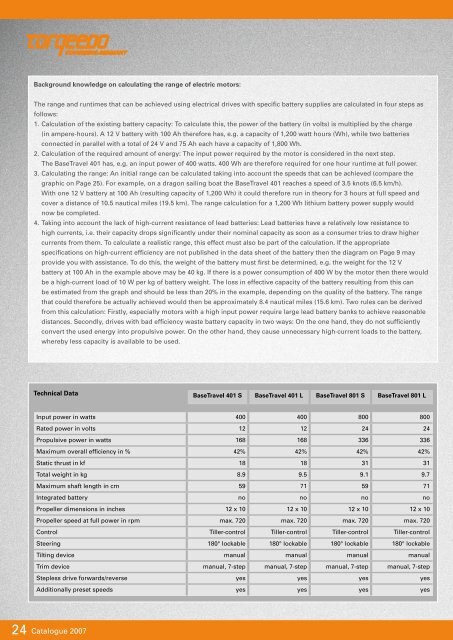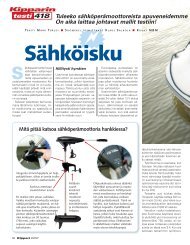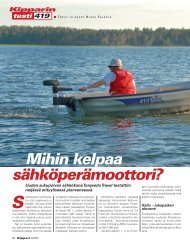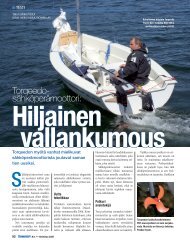1 2 3 - Torqeedo
1 2 3 - Torqeedo
1 2 3 - Torqeedo
Create successful ePaper yourself
Turn your PDF publications into a flip-book with our unique Google optimized e-Paper software.
Background knowledge on calculating the range of electric motors:<br />
The range and runtimes that can be achieved using electrical drives with specific battery supplies are calculated in four steps as<br />
follows:<br />
1. Calculation of the existing battery capacity: To calculate this, the power of the battery (in volts) is multiplied by the charge<br />
(in ampere-hours). A 12 V battery with 100 Ah therefore has, e.g. a capacity of 1,200 watt hours (Wh), while two batteries<br />
connected in parallel with a total of 24 V and 75 Ah each have a capacity of 1,800 Wh.<br />
2. Calculation of the required amount of energy: The input power required by the motor is considered in the next step.<br />
The BaseTravel 401 has, e.g. an input power of 400 watts. 400 Wh are therefore required for one hour runtime at full power.<br />
3. Calculating the range: An initial range can be calculated taking into account the speeds that can be achieved (compare the<br />
graphic on Page 25). For example, on a dragon sailing boat the BaseTravel 401 reaches a speed of 3.5 knots (6.5 km/h).<br />
With one 12 V battery at 100 Ah (resulting capacity of 1,200 Wh) it could therefore run in theory for 3 hours at full speed and<br />
cover a distance of 10.5 nautical miles (19.5 km). The range calculation for a 1,200 Wh lithium battery power supply would<br />
now be completed.<br />
4. Taking into account the lack of high-current resistance of lead batteries: Lead batteries have a relatively low resistance to<br />
high currents, i.e. their capacity drops significantly under their nominal capacity as soon as a consumer tries to draw higher<br />
currents from them. To calculate a realistic range, this effect must also be part of the calculation. If the appropriate<br />
specifications on high-current efficiency are not published in the data sheet of the battery then the diagram on Page 9 may<br />
provide you with assistance. To do this, the weight of the battery must first be determined, e.g. the weight for the 12 V<br />
battery at 100 Ah in the example above may be 40 kg. If there is a power consumption of 400 W by the motor then there would<br />
be a high-current load of 10 W per kg of battery weight. The loss in effective capacity of the battery resulting from this can<br />
be estimated from the graph and should be less than 20% in the example, depending on the quality of the battery. The range<br />
that could therefore be actually achieved would then be approximately 8.4 nautical miles (15.6 km). Two rules can be derived<br />
from this calculation: Firstly, especially motors with a high input power require large lead battery banks to achieve reasonable<br />
distances. Secondly, drives with bad efficiency waste battery capacity in two ways: On the one hand, they do not sufficiently<br />
convert the used energy into propulsive power. On the other hand, they cause unnecessary high-current loads to the battery,<br />
whereby less capacity is available to be used.<br />
Technical Data<br />
BaseTravel 401 S BaseTravel 401 L BaseTravel 801 S BaseTravel 801 L<br />
Input power in watts 400 400 800 800<br />
Rated power in volts 12 12 24 24<br />
Propulsive power in watts 168 168 336 336<br />
Maximum overall efficiency in % 42% 42% 42% 42%<br />
Static thrust in kf 18 18 31 31<br />
Total weight in kg 8.9 9.5 9.1 9.7<br />
Maximum shaft length in cm 59 71 59 71<br />
Integrated battery no no no no<br />
Propeller dimensions in inches 12 x 10 12 x 10 12 x 10 12 x 10<br />
Propeller speed at full power in rpm max. 720 max. 720 max. 720 max. 720<br />
Control Tiller-control Tiller-control Tiller-control Tiller-control<br />
Steering 180° lockable 180° lockable 180° lockable 180° lockable<br />
Tilting device manual manual manual manual<br />
Trim device manual, 7-step manual, 7-step manual, 7-step manual, 7-step<br />
Stepless drive forwards/reverse yes yes yes yes<br />
Additionally preset speeds yes yes yes yes<br />
24 Catalogue 2007









